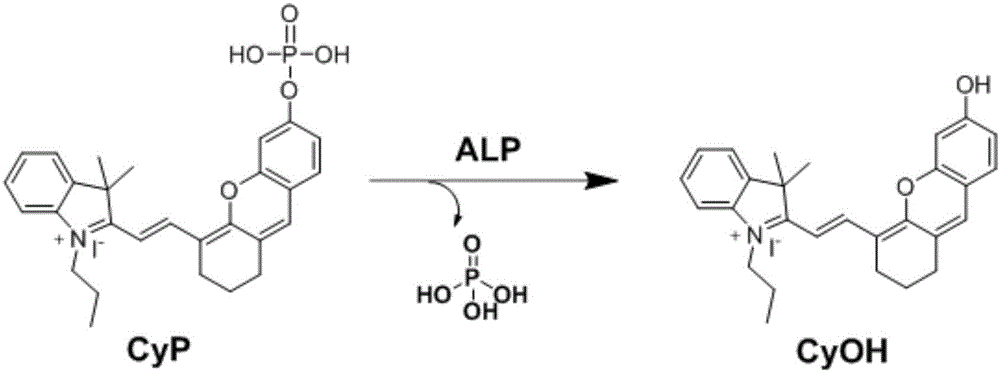Preparation method and application of near-infrared alkaline phosphatase fluorescence probe
A fluorescent probe and phosphatase technology, applied in the field of fluorescent probes, to achieve rapid response
- Summary
- Abstract
- Description
- Claims
- Application Information
AI Technical Summary
Problems solved by technology
Method used
Image
Examples
Embodiment 1
[0028] Synthesis of fluorescent probes
[0029] Synthesis of CyOH: In a 100 mL round bottom flask, resorcinol (1.0 mmol, 110 mg) and potassium carbonate (1.0 mmol, 138 mg) were sequentially added, and then 20 mL of acetonitrile was added as a solvent. After magnetic stirring for 10 min at room temperature, a solution of IR-780 (0.5 mmol, 305 mg) dissolved in 20 mL of acetonitrile was added dropwise to the reaction solution. N 2 Under protection, heat to 50°C and continue to stir for about 4 hours. After the reaction is completed, remove the solvent with a rotary evaporator. The crude product is separated and purified by column chromatography using dichloromethane / methanol at a ratio of 20:1 (volume ratio) as eluent to obtain Blue-green solid 169 mg, yield 82%. 1 H NMR (400MHz, CDCl 3 ):δ8.02(d,1H,J=13.2Hz),7.25-7.21(m,2H),7.14(t,1H,J=7.6Hz),7.06-7.03(m,2H),6.97(s, 1H), 6.90(d, 1H, J=8.0Hz), 6.81(d, 1H, J=8.0Hz), 5.56(d, 1H, J=13.2Hz), 3.76(t, 2H, J=7.2Hz) ,2.67(t,2H,J=6.0...
Embodiment 2
[0032] Preparation of solution for interaction between fluorescent probe and ALP
[0033] A certain amount of fluorescent probe was dissolved in EtOH to obtain a concentration of 1.0 × 10 -4 mol L -1 Probe stock solution. Add 1.0mL of the spare solution of the probe into a 10mL volumetric flask, and after constant volume with buffer solution, the obtained concentration is 1.0×10 -5 mol L -1 fluorescent probe solution. ALP was formulated to the following concentrations (0, 0.01, 0.25, 0.5, 0.75, 1.0, 1.25, 1.5, 1.75, 2.0 U / mL).
Embodiment 3
[0035] Measurement of Fluorescence Spectrum of Interaction of Fluorescent Probe with ALP
[0036] A buffer solution with a pH value of 8 was used as a solvent to measure the fluorescence spectrum of the fluorescent probe interacting with ALP, and the results were as follows: figure 1 . The concentration of the fluorescent probe is 10 μM, the concentration of ALP is 0, 0.01, 0.25, 0.5, 0.75, 1.0, 1.25, 1.5, 1.75, 2.0 U / mL, the excitation wavelength is fixed at 595nm, and the emission wavelength range is 685-850nm. The slit width is 10.0nm / 10.0nm. From figure 1 It can be seen that with the addition of ALP, the emission peak at 703nm is greatly enhanced, and with the increase of ALP concentration, the fluorescence intensity of the probe is continuously enhanced. Such as figure 1 As shown in the inset of , the fluorescence intensity has a linear relationship with the concentration of ALP, the linear range is 0.01-2.0U / mL, and the detection limit is 0.003U / mL. The fluorescence...
PUM
 Login to View More
Login to View More Abstract
Description
Claims
Application Information
 Login to View More
Login to View More - R&D
- Intellectual Property
- Life Sciences
- Materials
- Tech Scout
- Unparalleled Data Quality
- Higher Quality Content
- 60% Fewer Hallucinations
Browse by: Latest US Patents, China's latest patents, Technical Efficacy Thesaurus, Application Domain, Technology Topic, Popular Technical Reports.
© 2025 PatSnap. All rights reserved.Legal|Privacy policy|Modern Slavery Act Transparency Statement|Sitemap|About US| Contact US: help@patsnap.com



